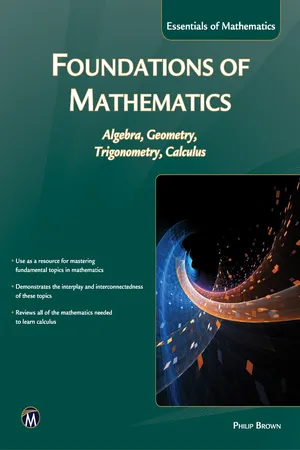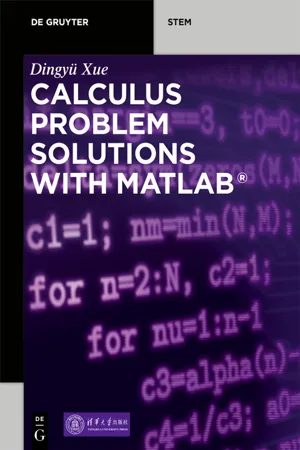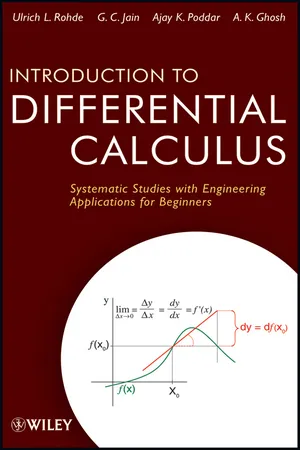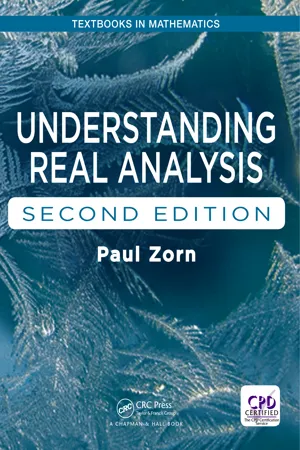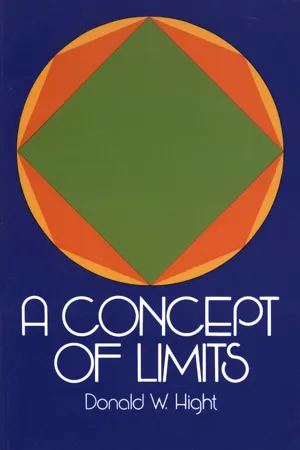Mathematics
Limit of Vector Valued Function
The limit of a vector-valued function is the point that the function approaches as the input approaches a certain value. It is defined as the vector that the function gets arbitrarily close to as the input approaches the given value. The limit of a vector-valued function exists if and only if the limit of each component function exists.
Written by Perlego with AI-assistance
Related key terms
Related key terms
1 of 4
Related key terms
1 of 3
5 Key excerpts on "Limit of Vector Valued Function"
- eBook - ePub
Foundations of Mathematics
Algebra, Geometry, Trigonometry and Calculus
- Philip Brown(Author)
- 2016(Publication Date)
- Mercury Learning and Information(Publisher)
7LIMITS
7.1INTRODUCTION
The concept of a limiting value of a function plays an important role in calculus, because the formal definition of the derivative of a function at a point in its domain can be expressed as the limiting value of a particular expression involving the function.The meaning of “limit” in mathematics is more subtle than that in everyday speech. A speed limit that applies on a highway is a speed that motorists may not exceed. The meaning of “limit” in mathematics is similar to that in the following sentence: “In the minute to win it competition the contestant was pushed to the limit of his abilities.” Thus, a “limit” in mathematics is something (like a number or geometrical figure) that is approached and might or might not be reached.It is in keeping with the historical approach of this book to begin with the method of exhaustion as an example of an occurrence of a limit in mathematics, as this is the method that Archimedes and other Greek mathematicians of his time used to calculate approximate values of certain areas, for example, the area of a disk. In section 7.3 , the concept of a limit is explained carefully using number sequences without giving the completely rigorous treatment (involving ε arguments) that are given in more advanced textbooks. Students of this book will probably not benefit from such a theoretical approach at this stage.The notion of the left or right limit of a function, introduced simplistically (by reading from a graph) in section 7.4 , leads to the definition of continuity of a function in section 7.5 . The property of continuity is important because many theorems about functions, for example, the Intermediate Value Theorem (in section 7.7 ), apply only to functions that are continuous.Most of the skills that students need to learn in this chapter are introduced in sections 7.6 and 7.8 - eBook - ePub
- Dingyü Xue(Author)
- 2020(Publication Date)
- De Gruyter(Publisher)
Continuity of functions is studied. In Section 3.3, poles and singularities of complex-valued functions are studied, and the computations of residues are presented. In Section 3.4, limit problems of multivariate functions are explored, and based on bivariate functions, the problems of sequential and multiple limits are studied. The most important MATLAB function in this chapter is limit() function. It is not exaggerating to say that, once you have mastered the use of such a function, you can solve with ease almost all the limit-related problems in [ 5 ]. 3.1 Limits of univariate functions 3.1.1 The ε – δ definition For a given function f (x), the limit problem can mathematically be denoted as (3.1.1) L = lim x → x 0 f (x), and the physical meaning is that, when the independent variable x is sufficiently close to the target x 0, the function value f (x) is close to the limit. In calculus textbooks, the following well-explained ε – δ definition is established. Definition 3.1 (The ε–δ definition). For any preselected ε > 0, if there exists a positive δ satisfying 0 < | x − x 0 | < δ such that | f (x) − L | < ε, the limit lim x → x 0 f (x) = L. Example 3.1. Constant e is an irrational number, whose first 32 digits are e ≈ 2.7182818284590452353602874713527. >> vpa(exp(sym(1)),32) % more digits can also be displayed Example 3.2. Verify through ε – δ definition an important. limit lim x → 0 (1 + 1 x) x = e. Solutions. Consider the inequality | (1 + 1 / x) x − e | < ε, which is nonlinear in x. It is not possible to solve the inequality without the use of computers. In fact, the inequality problem can better be solved by converting it to nonlinear equations. For a given ε, solve the equation (1 + 1 / x) x − e − ε = 0. The boundary of solutions can be found, and the absolute value of the boundary is the expected δ. A very handy univariate equation solver fzero() is provided in MATLAB - eBook - ePub
Introduction to Differential Calculus
Systematic Studies with Engineering Applications for Beginners
- Ulrich L. Rohde, G. C. Jain, Ajay K. Poddar, A. K. Ghosh(Authors)
- 2012(Publication Date)
- Wiley(Publisher)
Chapter 7a The Concept of Limit of a Function 7a.1 IntroductionAddition, subtraction, multiplication, division, raising to a power, extracting a root, taking a logarithm, or a modulus are operations of elementary mathematics. In order to pass from elementary mathematics to higher mathematics, we must add to this list one more mathematical operation, namely, “finding the limit of a function ”.The notion of limit is an important new idea that lies at the foundation of Calculus. In fact, we might define Calculus as the study of limits. It is, therefore, important that we have a deep understanding of this concept. Although the topic of limit is rather theoretical in nature, we shall try to represent it in a very simple and concrete way.7a.2 Useful Notations Our work for understanding the concept of limit will be simplified if we use certain notations. Therefore, let us first get familiar with these notations:- Meaning of the notation x → a:
Let x be a variable and “a ” be a constant. If x assumes values nearer and nearer to “a ” (without assuming the value “a ” itself), then we say x tends to a (or x approaches a ) and we write x → a . In other words, the procedure of giving values to x (from the domain of “f ”) nearer and nearer to “a ”, but not permitting x to assume the value “a ”, is denoted by the symbol “x → a ”.Thus, x → 1 means, we assign values to x which are nearer and nearer to 1 (but not permitting x to assume the value 1), which means that x comes closer and closer to “1”, reducing the distance between “x ” and “1”, in the process.Thus, by the statement “x ” tends to “a ”, we mean that:i. x ≠ a ,ii. x assumes values nearer and nearer to a , andiii. The way in which x should approach a is not specified.(Different ways of approaching “a ” are given below.)
- Meaning of x → a −
If we consider x to be approaching closer and closer to “a ” from the left side (i.e., through the values less than “a ”), then we denote this procedure by writing x →a − and read it as “x” tends to “a minus
- eBook - ePub
- Paul Zorn(Author)
- 2017(Publication Date)
- Chapman and Hall/CRC(Publisher)
CHAPTER 3Limits and Continuity
3.1 Limits of FunctionsThis chapter is about continuous functions and their properties. As a foretaste, consider this reasonable‐sounding claim about a function f :If f ( - 1) = - 2 and f (1) = 5, then f (a ) = 0 for some a ∊ ( - 1, 1) .Is this true? If a graph passes through the pointsand( - 1 , - 2 ), must it also cross the x -axis somewhere in between? Must there also be an input b with f (b ) = π ?( 1 , 5 )Both answers turn out to be “yes”—if the function f is continuous everywhere along the input interval [−1, 1]. In this case, answers follow from the famous intermediate value theorem , which we will carefully state and prove later in this chapter. To prove such results we’ll draw on earlier work with completeness, suprema and infima, limits, the Bolzano–Weierstrass theorem, and more. Our work starts, as usual, with clear definitions of words like “limit” (as applied to functions) and “continuous.”The IV theorem says that the range of a continuous function has no “gaps”; details come later.Defining Limits of Functions
Most of us emerge from elementary calculus courses with a rough and ready view of function limits. To say that limx →3f (x ) = 5, for example, means something like f (x ) approaches 5 as x approaches 3, or f (x ) ≈ 5 when x ≈ 3.These views are not incorrect, but they are too vague to be useful for building theory or proving theorems. What exactly does “approaches” mean? How close to 3 must x be for x ≈ 3 to hold? We need a precise definition.Definition 3.1 (Limit of a function). Let f be a function whose domain includes an open interval I containing a , except perhaps for x = a . Let L be a number. We writeObserve, right away, two important subtleties about domains:if, for every ɛ > 0, there exists δ > 0 such that |f (x ) - L | < ɛ whenever x ∊ I and 0 < |x - a | < δ .limf( x )= L• At x = a : The value f (a ) itself need not be defined for the limit to exist at x = a . Indeed, the whole point of finding such a limit is often to do with a “missing” or mysterious function value. If f (a ) is defined, that’s fine, but it’s irrelevant to the definition, which avoids all mention of f (a - eBook - ePub
- Donald W. Hight(Author)
- 2012(Publication Date)
- Dover Publications(Publisher)
§3–2 ). Also, when we proved by definition of a limit that a certain limit existed, we assumed that the statementinferred that if x ∈ Δ, then x ∈ Df . Following are two definitions that a student may find in the literature. These two apply to limits of a real sequence or function and differ from our definitions primarily in the conditions on the domain Df of a function f. We state each definition in the language of the generalized limit:(i) Let f be a (real) function whose domain Df contains an element in every δ-set. Then limit f(x) = L iff for every ε > 0 there exists a δ-set Δ such that(ii) Let f be a (real) function. Then limit f(x) = L iff for every ε > 0 there exists a δ-set Δ such thatAlthough we have not studied the results of these definitions, we should be able to do so readily.As discussed in §3–6 , concepts frequently found in the high school mathematics curricula involve limits. In addition to these topics, high school and college mathematics students and their teachers are, to a varying extent, involved with limits in calculus.The central concept in calculus is the concept of limits that we have discussed. For instance, let f be a function whose domain contains a neighborhood of b. Then f has a derivative at b iff where L is a real number. We write L = f′(b) and call f′(b) the derivative of f at b. Thus, given a function f and a real number b we may determine the difference quotient function F, F(x) = as shown in Figure 3–6 , and then proceed to apply our definition, theorems, and understanding of the limit at b to F(x). A study of this limit, , is a study in differential calculus.
Index pages curate the most relevant extracts from our library of academic textbooks. They’ve been created using an in-house natural language model (NLM), each adding context and meaning to key research topics.
Explore more topic indexes
Explore more topic indexes
1 of 6
Explore more topic indexes
1 of 4
